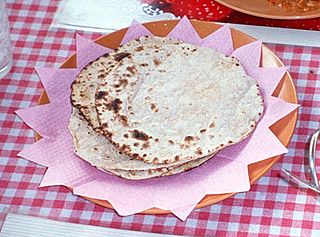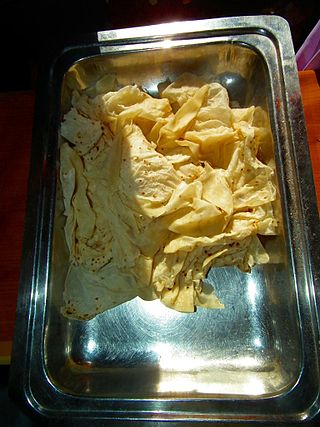 Peg bread sold at a Los Angeles market | |
| Type | Bread |
|---|---|
| Place of origin | Jamaica and West Indies |
Peg bread is a traditional Jamaican and West Indian bread type. [1] [2] It is usually served along with tea in the morning. [3]
 Peg bread sold at a Los Angeles market | |
| Type | Bread |
|---|---|
| Place of origin | Jamaica and West Indies |
Peg bread is a traditional Jamaican and West Indian bread type. [1] [2] It is usually served along with tea in the morning. [3]

Roti is a round flatbread native to the Indian subcontinent. It is popular in India, Sri Lanka, Pakistan, Nepal, Bangladesh, Maldives, Myanmar, Malaysia, Indonesia, Singapore, Thailand, Guyana, Suriname, Jamaica, Trinidad and Tobago, Mauritius, and Fiji. It is made from stoneground whole wheat flour, traditionally known as gehu ka atta, and water that is combined into a dough. Roti is consumed in many countries worldwide. Its defining characteristic is that it is unleavened. Naan from the Indian subcontinent, by contrast, is a yeast-leavened bread, as is kulcha. Like breads around the world, roti is a staple accompaniment to other foods.
Jamaican cuisine includes a mixture of cooking techniques, flavours and spices influenced by Amerindian, African, Irish, English, French, Portuguese, Spanish, Indian, Chinese and Middle Eastern people who have inhabited the island. It is also influenced by the crops introduced into the island from tropical Southeast Asia, many of which are now grown locally. A wide variety of seafood, tropical fruits and meats are available.

A hush puppy is a small, savory, deep-fried round ball made from cornmeal-based batter. Hushpuppies are frequently served as a side dish with seafood and other deep-fried foods.
Linstead is a town in the parish of St. Catherine, Jamaica in the West Indies. In 1991 its population was 14,144. It is located 12 mi/19 km NNW of Spanish Town.

A flatbread is a bread made with flour; water, milk, yogurt, or other liquid; and salt, and then thoroughly rolled into flattened dough. Many flatbreads are unleavened, although some are leavened, such as pizza and pita bread.
An electuary is a medicine consisting of a powder or other ingredient mixed with something sweet such as honey to make it more palatable.
The culture of the Cayman Islands has been influenced by Afro-Caribbeans of Jamaica, colonists of Great Britain. In the 21st century, approximately 113 nationalities make up the residents on the three islands comprising the country. The total population of the Cayman Islands is 69,656 people spread throughout the island group, with the majority of the people found on Grand Cayman. Roughly 37,000 are generational Caymanians, with the remainder being immigrants, their children, and permanent residents.
Hard dough bread, also called hardo bread, is a Caribbean cuisine bread similar to the Pullman loaf or pain de mie, although hard dough bread tends to be sweeter. The dough consists of flour, water, yeast, salt and sugar. Additional ingredients such as treacle, molasses, and vegetable shortening can be used. It typically has a dense consistency and is typically brushed with sugared water before baking. It is a staple food in Jamaican households.

The Jamaican passport is issued to citizens of Jamaica for international travel. The passport is a Caricom passport as Jamaica is a member of the Caribbean Community.

Coco bread is eaten in Jamaica and other areas of the Caribbean. The bread contains some coconut milk, and is starchy and slightly sweet in taste. It is often split in half and stuffed with a Jamaican patty to form a sandwich in the same manner as a pasty barm.

Bammy is a traditional Jamaican cassava flatbread descended from the simple flatbread eaten by the Arawaks, Jamaica's original inhabitants. Today, it is produced in many rural communities and sold in stores and by street vendors in Jamaica and abroad.

Rumali roti also called Manda. It is eaten with tandoori dishes. The word rumal means handkerchief in many north Indian languages, and the name rumali roti means handkerchief bread. In Punjab, it is also known as lamboo roti. Lamboo simply means long in Punjabi. It is also known as dosti roti in the Caribbean.

Bulla cake, usually referred to as bulla, is a rich Jamaican cake made with molasses and spiced with ginger and nutmeg, sometimes dark-colored and other times light-colored. Bulla are small loaves that are flat and round. They are inexpensive and easy to make using molasses, flour and baking soda. Bulla is traditionally a popular treat for schoolchildren. It is usually eaten with cheese, butter or avocado.

Toto is a small coconut cake in Jamaican cuisine served as a snack or dessert. The cake is typically prepared with shredded coconut, brown sugar, flour, baking soda and powder, and coconut milk. It may also be added with some flavorings such as allspice, nutmeg, ginger, and salt.
The Jerusalem Bread Foundation was a minor political party in Jamaica.

The festivals or Jamaican festivals are a kind of deep-fried bread, typical of Jamaican cuisine. Despite its slightly sweet taste, is served as a side dish to dishes such as fried fish, escovitch fish or jerk chicken.